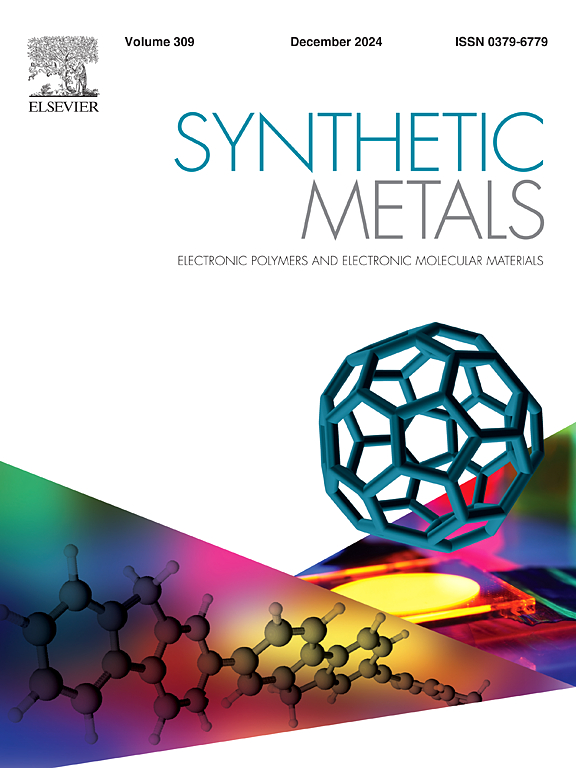酞菁钴(CoPc)与还原氧化石墨烯官能化CoPc杂化物作为水中重金属离子传感元件的比较
IF 4.6
3区 材料科学
Q2 MATERIALS SCIENCE, MULTIDISCIPLINARY
引用次数: 0
摘要
本研究采用石英晶体微天平(QCM)技术对比研究了4-吡啶基-噻二唑四取代酞菁钴(CoPc)和还原氧化石墨烯(rGO)修饰CoPc杂化物在水样中的重金属离子(HMI)传感性能。研究了四种主要hmi (As3 +、Hg2+、Pb2+和Cd2+)在CoPc和rGO/CoPc上的吸附平衡等温线,并建立了模型。结果表明,还原氧化石墨烯的羧基和强路易斯碱性质提高了还原氧化石墨烯/CoPc纳米复合材料的HMI敏感性。rGO/CoPc对As3+离子的敏感性为3.9 × 104 Hz/mg l - 1, CoPc对As3+离子的敏感性为6.7 × 102 Hz/mg l - 1。对CoPc和CoPc/还原氧化石墨烯混合传感器进行了一组Pb2+离子的长期稳定性和可重用性测试。CoPc/rGO混合材料在~ 500 h后表现出优异的长期稳定性,保持约95 %的初始灵敏度,而基于CoPc的传感器则为80 %。采用五种不同的(Langmuir, Freundlich, Elovich, Temkin和Jovanovic)双参数吸附等温线模型,模拟了四种hmi水溶液对CoPc和rGO/CoPc的吸附平衡等温线。回归分析表明,还原氧化石墨烯对CoPc的功能化对hmi吸附等温线有较强的影响。本文章由计算机程序翻译,如有差异,请以英文原文为准。
Comparison of cobalt phthalocyanine (CoPc) and reduced graphene oxide functionalized CoPc hybrid as sensing element for heavy metal ions in water
In this study, heavy metal ion (HMI) sensing properties of 4-pyridinyl-oxadiazole tetrasubstituted cobalt phthalocyanine (CoPc) and reduced graphene oxide (rGO) modified CoPc hybrid in water samples were comparatively investigated by quartz crystal microbalance (QCM) technique. The adsorption equilibrium isotherms of four main HMIs (As3 +, Hg2+, Pb2+, and Cd2+) from aqueous solutions onto CoPc and rGO/CoPc were also studied and modelled. Results showed that the presence of carboxyl groups and strong Lewis base nature of rGO improves the HMI sensitivity of rGO/CoPc nanocomposite. A sensitivity value of 3.9 × 104 Hz/mg l −1 was obtained for As3+ ions with rGO/CoPc while it was 6.7 × 102 Hz/mg l−1 with CoPc. A set of long-term stability and reusability tests was performed on both CoPc and CoPc/rGO hybrid based sensors for Pb2+ ions. CoPc/rGO hybrid exhibits excellent long-term stability after ∼ 500 h, maintaining about 95 % of its initial sensitivity, compared to 80 % for the CoPc-based sensor. The adsorption equilibrium isotherms of the four HMIs from aqueous solutions onto CoPc and rGO/CoPc were modelled using five different (Langmuir, Freundlich, Elovich, Temkin, and Jovanovic) two parameter adsorption isotherm models. Regression analysis showed that the functionalization of the CoPc with rGO has a strong effect on the HMIs adsorption isotherm.
求助全文
通过发布文献求助,成功后即可免费获取论文全文。
去求助
来源期刊

Synthetic Metals
工程技术-材料科学:综合
CiteScore
8.30
自引率
4.50%
发文量
189
审稿时长
33 days
期刊介绍:
This journal is an international medium for the rapid publication of original research papers, short communications and subject reviews dealing with research on and applications of electronic polymers and electronic molecular materials including novel carbon architectures. These functional materials have the properties of metals, semiconductors or magnets and are distinguishable from elemental and alloy/binary metals, semiconductors and magnets.
 求助内容:
求助内容: 应助结果提醒方式:
应助结果提醒方式:


